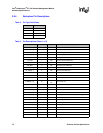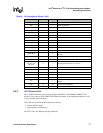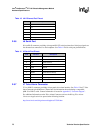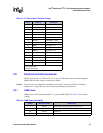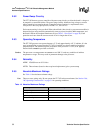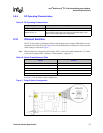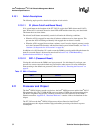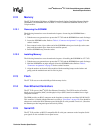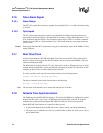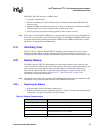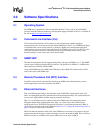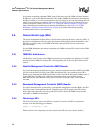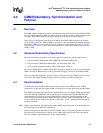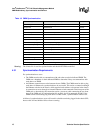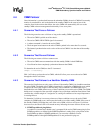
Intel
®
NetStructure
TM
ZT 7102 Chassis Management Module
Hardware Specifications
34 Technical Product Specification
2.16 Telco Alarm Signal
2.16.1 Alarm Relays
The ZT 7102’s alarm relay circuits are capable of carrying 60 VDC or 1 A, with a maximum rating
of 30 VAC.
2.16.2 Opto Inputs
The ZT 7102 accepts timed pulse inputs for clearing Minor and Major alarm states (there is no
reset for the Critical state). Reset is accomplished by asserting a voltage differential from 3.3 V to
48 V for between 200 and 300 ms. The acceptable voltage range is from 0 to 48 VDC continuous
(handles up to 60 VDC at a 50 percent duty cycle). The current drawn by a reset input should not
exceed 12 mA.
Caution: Do not apply more than 60 V (maximum) to any pin or combination of pins on the CMM's J7 Telco
Alarm connector.
2.17 Real Time Clock
A Dallas Semiconductor* DS1307 Serial Real-Time Clock allows the ZT 7102 to keep track of
time for accurate event logging. The DS1307 features 56 bytes of nonvolatile SRAM, a 100-year
calendar, and battery backup.
The Real-Time Clock keeps time in UTC only. If the time is set for a different time zone, as in the
example below, the difference will be automatically calculated giving the UTC equivalent. In this
example, the time will be set 8 hours ahead of the local time.
To set the real-time clock, enter the correct date and time in the following format:
setdate 'Thu Apr 01 09:04:29 PST 2004'
The above command would set the time and date to the following:
Thu Apr 1 17:04:29 UTC 2004
Note: The real-time clock should be set to current date and time out of the box.
2.18 Network Time Synchronization
The CMM supports the RFC 868 Time Protocol. This allows the CMM to be configured to retrieve
the date and time from a server over a TCP/IP network using the rdate command. To properly
configure time synchronization using the RFC 868 Time Protocol, follow the steps below.
Enable RFC 868 Time Protocol on a Linux/Unix Host (server):
• In general this depends upon the OS and version. Please consult your OS documentation.
• The easiest way to enable this service is to use the OS GUI to enable the "time" server. This is
part of inetd/xinetd.



